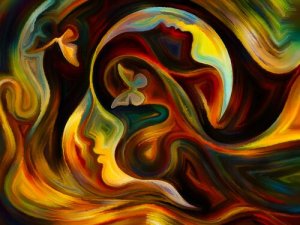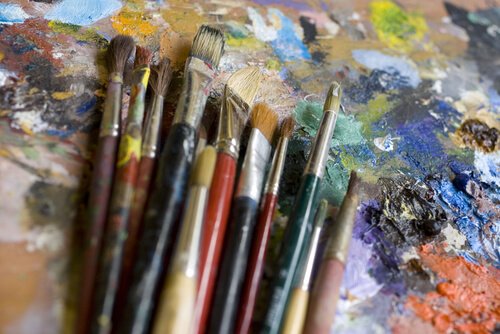4 Ways to Overcome Trauma Through Art

When we go through a complex and painful situation, we may start to believe there’s no way out. We’ve all been in this situation at some point in our lives. Sometimes we become self-absorbed and stop seeing the world around us. Traumatic situations leave us not knowing what to do. Trauma paralyzes us since we can’t stop thinking about what happened.
A trauma is an emotional wound that affects our well-being. The truth is that most of us will likely experience some type of trauma. There are some strategies that we can use so we don’t become trapped in our pain. In this regard, art can transform pain.
Through art, we can transform the pain that we’re feeling. Overcoming trauma consists of remodeling that traumatic situation that overwhelms us by using creativity. This helps transform suffering into learning. As we go through this process, we begin to transform that emotional wound. Let’s see how to overcome trauma through art.
“The function of art in society is to build. We rebuild when we’re in danger of collapsing.”
-Sigmund Freud-
Connect with the deepest part of you to overcome trauma through art
To overcome trauma using art, it’s important to connect with the depths of your soul. You have to identify whatever it is you’re feeling and be able to transform those feelings. This process consists of thinking about yourself and trying to identify what emotions the traumatic situation is making us feel.

This deep inner connection will help you decide how to go forward in the healing process. If you’re having a difficult time connecting at first, don’t worry or think that something’s wrong with you. This soul-searching process takes time and practice. However, it’ll be much easier if you’re in a pleasant atmosphere you enjoy being at. For example, a place where you can be alone and listen to the music you like. This place can be anywhere: a park, your house, a beach… the options are endless.
Once you identify what you’re feeling, you can start to channel those feelings into art. You can think about composing a song, writing, painting, dancing, singing, or making a sculpture. Think of your deepest feelings associated with that emotional wound. Begin to shape those feelings into a creative work of art.
Be yourself
When it comes to your work, it’s important for you to be yourself. Don’t get caught up thinking about what others want or are expecting from you. Think of yourself and how much value you have as a unique individual with your own talents. You more than anyone else know your strengths and weaknesses. Recognizing them will make it easier for you to express them in your work.
Don’t reject the ideas that your mind creates. Rather, put them in your work. Find your own strengths and be tolerant and open to your past. Think about what you’ve learned from the painful situations you’ve experienced. How can you transform them with creativity?
Avoid judging yourself. Give yourself the opportunity to be who you really are with your own values and imperfections. You can put all those ideas that come to mind into your work. It doesn’t matter if they’re painful or not. Allow yourself to put all the pain you’ve been carrying inside into your work of art.
Giving yourself permission to show who you are is the best way to increase creativity. To overcome trauma through art, transform it with your own body and creativity. Your artistic tools will turn that emotional wound into something beautiful.
What’s the best way to facilitate the creative process?
We propose the following strategies to boost your creativity so that you can overcome whatever pain you’re experiencing:
- Brainstorm and write down all your ideas.
- Listen to yourself.
- Lovingly accept all your thoughts and emotions.
- Don’t judge yourself.
- Think about what you can learn from the painful situation.
- Think of a way to transform the emotional wound and show it in your work.
- Choose a place where you feel comfortable.
- Choose the materials you’ll use.
- Play the music you enjoy the most.
All of this will help you with your creative work. Get in tune with yourself, the place, and the situation that’s troubling you. With learning and transformation, that problematic situation can leave your body in a creative way. As you start to think more and more about what’s bothering you, it’ll become clearer how you want to portray your emotions in your work.

Different ways of using art to overcome trauma
Borus Cyrulnik, psychoanalyst and neurologist at the University of Var, in France, says that art facilitates the expression of what’s difficult to put into words. He says that art is a means of liberation and emotional control that allows the artist to feel heard. Thus, he aims to “beat trauma with art.”
Artists and psychologists have studied the importance of art in overcoming traumatic experiences. Here we’ll show you some different outlets:
- Art therapy. Psychology, art, and education come together to establish a discipline that seeks emotional well-being. It uses art as a therapeutic route, which psychologists call art therapy.
- Psychoanalysis. Through art, we express unconscious aspects, such as those from a traumatic situation. Creativity is a means of expression, catharsis, and liberation.
- Gestalt. This idea proposes that a person can recreate reality from the stimuli they experience in their lives. Therefore, if we believe we can use perceptions to transform negative situations, we can do this through art.
- Psychoeducation. Psychoeducation proposes that it’s possible to transform experiences by remodeling those experiences. They say that a facilitating element is our creativity.
- Art workshops. Creativity is a way of expressing emotions. In addition, according to art historian Ernst Gombrich, it’s a form of perception and reality. Therefore, we can capture different situations through the creative process.
- Comprehensive psychology. This promotes people’s creativity by developing the conscience.
Art is healing
Art allows us to express the ideas and feelings that are associated with our trauma. Thus, art is a vehicle that allows us to communicate and transform the emotions that are bothering us. It’s a wonderful method to transform our trauma into a creative work of art.
Art is undoubtedly one of the ways to overcome trauma. It’s a great means to connect with the deepest part of yourself and begin to mold and reshape that painful situation. All you have to do is choose the materials and the type of art you like the most and get to work! Transform your emotional wounds through art today.
“Every wounded man is forced to change.”
-Boris Cyrulnik-
When we go through a complex and painful situation, we may start to believe there’s no way out. We’ve all been in this situation at some point in our lives. Sometimes we become self-absorbed and stop seeing the world around us. Traumatic situations leave us not knowing what to do. Trauma paralyzes us since we can’t stop thinking about what happened.
A trauma is an emotional wound that affects our well-being. The truth is that most of us will likely experience some type of trauma. There are some strategies that we can use so we don’t become trapped in our pain. In this regard, art can transform pain.
Through art, we can transform the pain that we’re feeling. Overcoming trauma consists of remodeling that traumatic situation that overwhelms us by using creativity. This helps transform suffering into learning. As we go through this process, we begin to transform that emotional wound. Let’s see how to overcome trauma through art.
“The function of art in society is to build. We rebuild when we’re in danger of collapsing.”
-Sigmund Freud-
Connect with the deepest part of you to overcome trauma through art
To overcome trauma using art, it’s important to connect with the depths of your soul. You have to identify whatever it is you’re feeling and be able to transform those feelings. This process consists of thinking about yourself and trying to identify what emotions the traumatic situation is making us feel.

This deep inner connection will help you decide how to go forward in the healing process. If you’re having a difficult time connecting at first, don’t worry or think that something’s wrong with you. This soul-searching process takes time and practice. However, it’ll be much easier if you’re in a pleasant atmosphere you enjoy being at. For example, a place where you can be alone and listen to the music you like. This place can be anywhere: a park, your house, a beach… the options are endless.
Once you identify what you’re feeling, you can start to channel those feelings into art. You can think about composing a song, writing, painting, dancing, singing, or making a sculpture. Think of your deepest feelings associated with that emotional wound. Begin to shape those feelings into a creative work of art.
Be yourself
When it comes to your work, it’s important for you to be yourself. Don’t get caught up thinking about what others want or are expecting from you. Think of yourself and how much value you have as a unique individual with your own talents. You more than anyone else know your strengths and weaknesses. Recognizing them will make it easier for you to express them in your work.
Don’t reject the ideas that your mind creates. Rather, put them in your work. Find your own strengths and be tolerant and open to your past. Think about what you’ve learned from the painful situations you’ve experienced. How can you transform them with creativity?
Avoid judging yourself. Give yourself the opportunity to be who you really are with your own values and imperfections. You can put all those ideas that come to mind into your work. It doesn’t matter if they’re painful or not. Allow yourself to put all the pain you’ve been carrying inside into your work of art.
Giving yourself permission to show who you are is the best way to increase creativity. To overcome trauma through art, transform it with your own body and creativity. Your artistic tools will turn that emotional wound into something beautiful.
What’s the best way to facilitate the creative process?
We propose the following strategies to boost your creativity so that you can overcome whatever pain you’re experiencing:
- Brainstorm and write down all your ideas.
- Listen to yourself.
- Lovingly accept all your thoughts and emotions.
- Don’t judge yourself.
- Think about what you can learn from the painful situation.
- Think of a way to transform the emotional wound and show it in your work.
- Choose a place where you feel comfortable.
- Choose the materials you’ll use.
- Play the music you enjoy the most.
All of this will help you with your creative work. Get in tune with yourself, the place, and the situation that’s troubling you. With learning and transformation, that problematic situation can leave your body in a creative way. As you start to think more and more about what’s bothering you, it’ll become clearer how you want to portray your emotions in your work.

Different ways of using art to overcome trauma
Borus Cyrulnik, psychoanalyst and neurologist at the University of Var, in France, says that art facilitates the expression of what’s difficult to put into words. He says that art is a means of liberation and emotional control that allows the artist to feel heard. Thus, he aims to “beat trauma with art.”
Artists and psychologists have studied the importance of art in overcoming traumatic experiences. Here we’ll show you some different outlets:
- Art therapy. Psychology, art, and education come together to establish a discipline that seeks emotional well-being. It uses art as a therapeutic route, which psychologists call art therapy.
- Psychoanalysis. Through art, we express unconscious aspects, such as those from a traumatic situation. Creativity is a means of expression, catharsis, and liberation.
- Gestalt. This idea proposes that a person can recreate reality from the stimuli they experience in their lives. Therefore, if we believe we can use perceptions to transform negative situations, we can do this through art.
- Psychoeducation. Psychoeducation proposes that it’s possible to transform experiences by remodeling those experiences. They say that a facilitating element is our creativity.
- Art workshops. Creativity is a way of expressing emotions. In addition, according to art historian Ernst Gombrich, it’s a form of perception and reality. Therefore, we can capture different situations through the creative process.
- Comprehensive psychology. This promotes people’s creativity by developing the conscience.
Art is healing
Art allows us to express the ideas and feelings that are associated with our trauma. Thus, art is a vehicle that allows us to communicate and transform the emotions that are bothering us. It’s a wonderful method to transform our trauma into a creative work of art.
Art is undoubtedly one of the ways to overcome trauma. It’s a great means to connect with the deepest part of yourself and begin to mold and reshape that painful situation. All you have to do is choose the materials and the type of art you like the most and get to work! Transform your emotional wounds through art today.
“Every wounded man is forced to change.”
-Boris Cyrulnik-
This text is provided for informational purposes only and does not replace consultation with a professional. If in doubt, consult your specialist.







